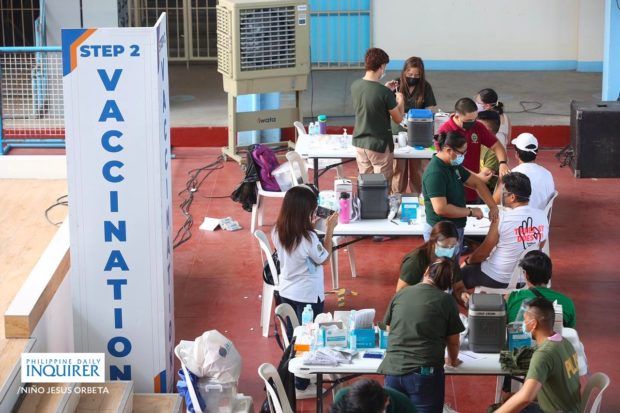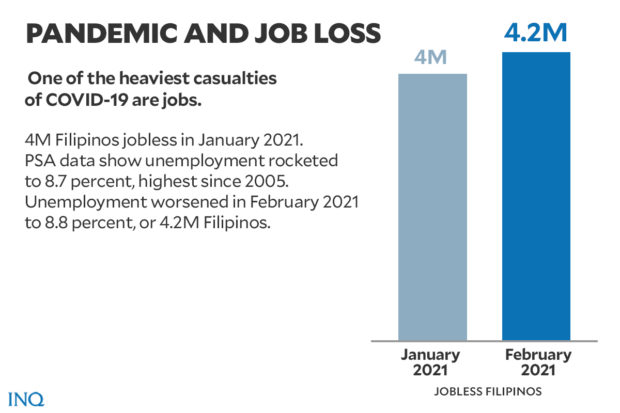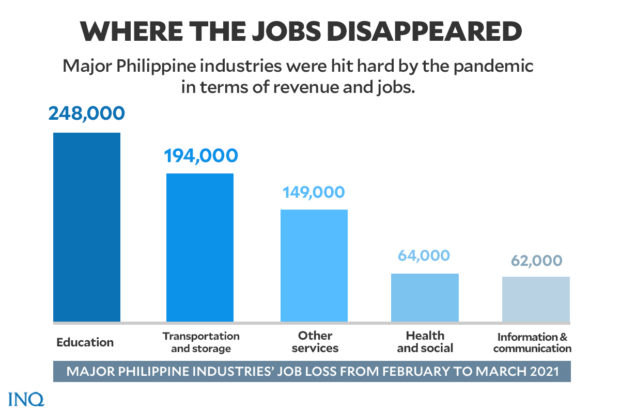Vaccination looms for workers, but are there enough doses?
MANILA, Philippines— As the national government continues its nationwide vaccine rollout, the demand for more vaccine supply was likely to increase starting in June as two more groups enter the vaccination program.
Starting in June, beneficiaries in the A4 and A5 classifications—essential frontline workers and the poor—may finally get their injections of available coronavirus vaccines.
However, according to vaccine czar Carlito Galvez Jr., the inoculation will still depend on the steadiness of the country’s vaccine supply.
READ: Gov’t to start vaccination of essential workers, indigents ‘after May’
While more Filipino workers wait for their turn to get inoculated, listed below are some details that highlight the impact of the COVID-19 pandemic on the labor sector.
Joblessness
Despite the government’s efforts to gradually reopen the economy to allow more people to go back to work, around 4 million Filipinos were still left jobless in January 2021.
Preliminary results of the Philippine Statistics Authority’s (PSA) labor force survey (LFS) last January showed that the country’s unemployment rate rocketed to 8.7 percent—the highest since 2005, according to National Statistician Dennis Mapa.
Last February, the unemployment rate continued to worsen as it hit 8.8 percent, or a total of 4.2 million Filipinos without a job.
READ: PSA records 4.2M unemployed Filipinos in February 2021
But as quarantine measures were eased, more Filipinos were able to actively participate in the labor force last March.
The PSA said a “much improved labor market condition” was seen that month when the unemployment rate eased to 7.1 percent, the lowest since the pandemic struck in 2020.
The PSA reported that the number of unemployed Filipinos declined to 3.44 million as people looked for other means of livelihood amid the prolonged pandemic and lockdown measures.
“The signs are indeed encouraging. Our economy is gradually getting back on track as more people are actively participating in the labor force and are becoming employed,” said Labor Secretary Silvestre Bello III.
READ: DOLE: Lowest unemployment rate since pandemic shows PH is bouncing back
In 2020, the International Labour Organization (ILO) estimated that around one-fourth of the country’s total labor force, or at least 10.9 million workers, was likely to face displacement due to the pandemic.
This can take the form of income declines, reduced working hours or complete joblessness.
The ILO also reported that women account for 38 percent of the jobs at risk of COVID-19 disruption.
Hardest hit industries
According to PSA, from February to March 2021, these industries suffered drastic cuts in unemployment:
- Education (248,000 workers laid off)
- Transportation and storage (194,000 workers)
- Other services (149,000 workers)
- Human health and social work (64,000 workers)
- Information and communication (62,000 workers)
ILO’s report on COVID-19’s impact on the Philippine labor market said at least 7.8 million workers, the most in unemployment figures, were at risk of displacement due to the pandemic in these sectors:
- Transportation and storage
- Accommodation and food services
- Wholesale and retail trade
- Construction
The first two sectors—including arts, entertainment and recreation—had been tagged by ILO as high risk and were “least likely to remain operative” due to quarantine restrictions. These were also likely to suffer from sharp slumps in demand during the pandemic, ILO said.
The organization also listed several sectors that were at medium risk of job displacements or suspension of operations:
- Water supply and waste management and construction
- Wholesale and retail trade
- Information and communication
- Finance and insurance
- Real estate
- Professional and science
ILO said these sectors may recover after a transition period.
Smaller businesses, however, suffered heavier during the pandemic.
In a paper published last February, the Tokyo-based Asian Development Bank Institute (ADBI) said at least 75 percent of micro, small and medium-scale (MSMEs) enterprises in the Philippines did not survive the first few weeks of the pandemic and were forced to close for good.
ADB think tank: PH MSMEs need targeted support to survive prolonged pandemic
Lost wages
The COVID-19 pandemic did not only impact the country’s employment but also dealt a huge blow on the Philippines’ overall income.
Socioeconomic Planning Secretary Karl Kendrick Chua, who heads the National Economic and Development Authority (Neda), estimated that P83.3 billion in potential income was lost within five weeks in the so-called National Capital Region Plus bubble—Metro Manila and the provinces of Bulacan, Cavite, Laguna and Rizal—when a new round of lockdowns had to be imposed during a surge of COVID-19 cases from March to end-April 2021.
Chua said that for every week of enhanced community quarantine (ECQ), the most stringent form of lockdown, at least P19.6 billion is lost and for every week of modified ECQ, at least P14.7 billion is lost.
“Because we had two weeks of ECQ and we had an extension of almost three weeks of MECQ—so a total of almost five weeks—the effect on people is P83.3 billion in foregone wages,” he said during a pre-recorded briefing aired on April 20.
“Of course, this is one of our concerns, but we believe that we should help each other so that we could find a solution to this spike—so that we can slowly reopen our economy and give it back to the people,” he added.
More workers, more doses
Data provided by the National Task Force (NTF) against COVID-19 showed that as of May 25, 2021, out of the total 7,829,050 vaccine doses in the country around 10,695 were administered as a first dose to beneficiaries falling under the A4 classification—essential workers.
At least 535 essential workers had already completed two doses.
READ: Over 1 million in PH now fully vaccinated vs COVID-19 — NTF
The Neda said that under the expanded A4 list, there will be an additional 35.5 million workers targeted for injection of coronavirus vaccines.
READ: Expanded A4 group to get 35.5 million more workers vaccinated — NEDA
The A4 priority group now includes:
- Private sector workers, who need to be physically present in their workplace
- Employees in government agencies and offices, including government-owned or controlled corporations and local government units
- Informal sector workers and self-employed individuals who work outside their homes
- Household workers
READ: Gov’t simplifies criteria for vaccination of essential workers
“The first phase of vaccine deployment for the expanded A4 group will be focused on approximately 13 million additional workers in NCR+8 since these areas make up the majority of COVID-19 cases in the country,” Neda said in a statement last Saturday (May 29).
“Another 22.5 million workers will subsequently be included from areas outside NCR+8, bringing the total estimate to 35.5 million,” it added.
The NCR Plus 8 area consists of Metro Manila, Bulacan, Cavite, Rizal, Laguna, Pampanga, Batangas, Cebu and Davao.
Since available vaccines in the Philippines required two doses per person, the government must acquire vaccine doses that are at least equivalent to or double those needed for beneficiaries on the A4 list.
Private vaccination programs
Aside from the vaccine acquired and administered by the national government, major conglomerates in the country have also stepped up and committed to providing doses for their employees.
This came after President Rodrigo Duterte allowed private firms to purchase coronavirus vaccines “at will” to protect employees from the dreaded disease.
Presidential spokesperson Harry Roque explained that it is permitted as long as the acquisition is done via a tripartite deal with the national government.
READ: Palace: Private sector purchase of COVID-19 jabs still via tripartite deal
Some of the private companies who have already ordered or announced plans to get doses of vaccines are:
- SM Supermalls: 600,000 vaccine doses for 150,000 employees
- Ayala Corporation: 450,000 vaccine doses
- Golden Arches Development Corporation/McDonald’s Philippine: 100,000 vaccine doses
- Lucio Tan Group (LTG): Vaccine doses for over 40,000 employees
- Aboitiz Group: Vaccines for 40,000 employees and 14,000 third party service providers
- San Miguel Corporation (SMC): Vaccines for over 70,000 employees including extended workforce
- Manny V Pangilinan: Vaccine doses for over 300,000 employees
- Coca-Cola: Vaccine doses for 10,000 associates
Two more companies—Grab Holdings and Jollibee Foods Corp.—have announced plans to acquire vaccines but data are not available on volume of doses.
READ: Retail giant SM to inoculate 150,000 employees vs COVID-19
READ: Ayala Group orders 450,000 doses of COVID-19 vaccine
READ: McDonald’s PH purchases COVID-19 vaccines, to vaccinate employees for free
Under the tripartite agreement, private companies have to donate half of the vaccines they procure to the national government.
TSB
READ: Firms can now buy own vaccines – Palace
For more news about the novel coronavirus click here.
What you need to know about Coronavirus.
For more information on COVID-19, call the DOH Hotline: (02) 86517800 local 1149/1150.
The Inquirer Foundation supports our healthcare frontliners and is still accepting cash donations to be deposited at Banco de Oro (BDO) current account #007960018860 or donate through PayMaya using this link.

















